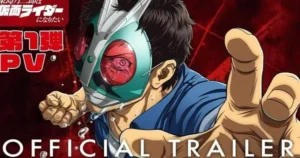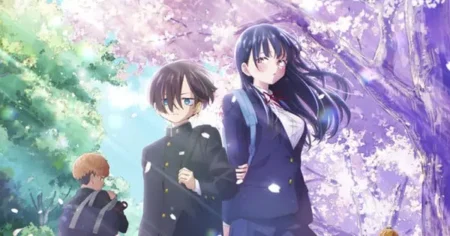A new project titled “Light-novel Anime” has been announced, promising a fresh wave of anime content adapted from original stories penned by popular light novel authors. This exciting venture aims to deliver unique narratives with character designs crafted by well-known illustrators.
Vertical Anime for a Modern Audience
The project is set to release short anime episodes in a vertical format, specifically designed for smartphone viewing. This approach caters to the growing trend of mobile content consumption, offering easily accessible entertainment for on-the-go audiences. The first two works, “Shōshin Time Leap” and “Femme Fatale Ikusei Keikaku,” are being released in parts each day over a 10-day period, with the initial episodes of “Shōshin Time Leap” already available as YouTube Shorts.
From Smartphones to Television
Recognizing the appeal of a broader audience, the project will also re-edit the vertical anime into a horizontal format for television broadcast. Starting July 12, these re-edited versions will air on ABC TV, TV Asahi, and their affiliates as part of the “Animazing !!!” programming block. The television program will be titled “Shūkan Ranobe Anime” (Weekly Light Novel Anime).
The Four Original Works
The “Light-novel Anime” project features four distinct works, each with its own unique story and creative team:
1. Shōshin Time Leap (Heartbreak Time Leap)
- Original Work, Series Composition, Script: nigozyu (known for The Detective Is Already Dead)
- Character Design: tanu (Tari Tari)
- Director: Tomoyasu Murata
- Script Cooperation: Fumiaki Maruto
- Literature Supervision: Takeshi Hagiwara
- Sound Director: Fumihiko Ōtera
- Main Theme: Misaki Umase
- Production: Ziine studio
- Cast:
- Tomoyo Takayanagi as Miri Wakana
- Shōgo Sakata as Takashi Wase
- Miyari Nemoto as Miyako Anami
- Reiji Kawashima as Ren Ashiya
Summary: On her final Christmas in high school, Miri confesses to her classmate Takashi, but he rejects her. In her despair, she clings to a past diary, which envelops her in light, sending her on a time leap.
2. Femme Fatale Ikusei Keikaku (Femme Fatale Training Plan)
Details for the remaining three works are currently limited. However, the project’s website and future announcements should reveal more information about their respective creative teams, casts, and storylines.
Light Novels: A Fertile Ground for Anime
Light novels, also known as ranobe, have long been a popular source of inspiration for anime adaptations. These Japanese young adult novels often feature distinctive art styles and engaging narratives that translate well to the animated medium. The partnership between light novel authors and illustrators has resulted in many successful anime series that have garnered both critical acclaim and commercial success.
Notable Light Novel Anime Adaptations
Numerous anime series have emerged from the world of light novels, captivating audiences with their unique stories and characters. Some of the most popular and influential light novel adaptations include:
- Sword Art Online: A science-fiction fantasy adventure about people trapped inside a virtual reality MMORPG.
- The Melancholy of Haruhi Suzumiya: A quirky and witty series about a high school girl who unwittingly has the power to reshape reality.
- Re:ZERO – Starting Life in Another World: A dark and edgy take on the “transported to another world” genre, where the protagonist must navigate a dangerous fantasy world while repeatedly dying and returning to a specific point in time.
- Ascendance of a Bookworm: A woman reincarnated into a medieval world lacking books, using her knowledge to recreate them.
- Mushoku Tensei: Jobless Reincarnation: The redemption story of a shut-in reborn into a fantasy world.
- Toradora!: A classic romance anime about the developing relationship between two high school students with contrasting personalities.
- My Teen Romantic Comedy SNAFU: A high school drama-comedy focusing on a loner whose sarcastic worldview is challenged when he joins the Volunteer Service Club.
- No Game No Life: Genius gamer siblings are transported to a world where all conflicts are resolved through games.
- The Apothecary Diaries: A fantasy romance series with mysterious twists, following a woman working in the imperial court.
- 86 -Eighty Six-: A military science fiction series exploring themes of discrimination and war.
- Classroom of the Elite: A psychological thriller set in a prestigious high school where students are ranked based on merit.
- Konosuba: A comedy about a NEET who is reincarnated into a fantasy world after an embarrassing death.
- Overlord: A dark fantasy about a gamer who becomes trapped in a virtual reality game as his powerful avatar.
- That Time I Got Reincarnated as a Slime: A man is reincarnated as a slime in a fantasy world and gains extraordinary powers.
The Appeal of Light Novel Adaptations
Light novels offer anime studios a wealth of creative material, including intricate world-building, compelling characters, and engaging plotlines. The adaptation process allows studios to enhance these elements with vibrant animation, captivating soundtracks, and skilled voice acting, creating a richer and more immersive experience for viewers.
Furthermore, light novel adaptations can introduce new audiences to the source material, driving sales of the original novels and expanding the fanbase for both the anime and the light novel series. This symbiotic relationship between the two mediums has contributed to the continued popularity of light novel anime adaptations.
Challenges in Adapting Light Novels
While light novels provide a strong foundation for anime adaptations, there are also challenges involved in translating the written word to the screen. One of the main difficulties is condensing the often extensive content of light novels into a manageable number of episodes. This can lead to certain plot points being omitted or simplified, which may disappoint fans of the original novels.
Another challenge is capturing the tone and atmosphere of the light novels in the anime adaptation. Light novels often rely on internal monologues and detailed descriptions to convey the characters’ thoughts and emotions, which can be difficult to replicate visually. Anime studios must find creative ways to express these elements through animation, dialogue, and music.
Deviations and Creative Liberties
In some cases, anime adaptations may deviate significantly from the original light novels, either due to time constraints, censorship issues, or creative decisions made by the production team. While these deviations can sometimes enhance the story, they can also alter the tone and pacing of the original work, leading to mixed reactions from fans.
It’s not uncommon for anime adaptations to take creative liberties with the source material, either by streamlining the plot, introducing new characters, or changing the ending. These changes can be controversial, as some fans prefer a faithful adaptation while others appreciate the unique interpretation offered by the anime.
The “Light-novel Anime” Project: A New Approach
The “Light-novel Anime” project represents a new approach to light novel adaptations, with its focus on short, vertical anime designed for smartphone viewing. This format allows for bite-sized storytelling that can be easily consumed on the go, while the re-edited horizontal versions cater to traditional television audiences.
By partnering with popular light novel authors and illustrators, the project aims to deliver high-quality content that captures the essence of the original stories while offering a fresh and innovative viewing experience. The project’s success could pave the way for more short-form anime adaptations in the future, catering to the evolving preferences of modern audiences.
The Future of Light Novel Anime
The “Light-novel Anime” project is just one example of the ongoing evolution of light novel anime adaptations. As the anime industry continues to grow and diversify, we can expect to see more innovative approaches to adapting light novels, with new formats, technologies, and creative collaborations.
The enduring popularity of light novels as a source of inspiration for anime suggests that this trend will continue for many years to come. With their engaging stories, memorable characters, and distinctive art styles, light novels offer a fertile ground for anime studios to create captivating and unforgettable experiences for audiences around the world.
The “Light-novel Anime” project is poised to make a significant contribution to this vibrant landscape, offering a fresh perspective on the art of adapting light novels and delivering unique entertainment to fans old and new. As the project unfolds, it will be exciting to see how these original stories are brought to life and how they resonate with audiences worldwide.









